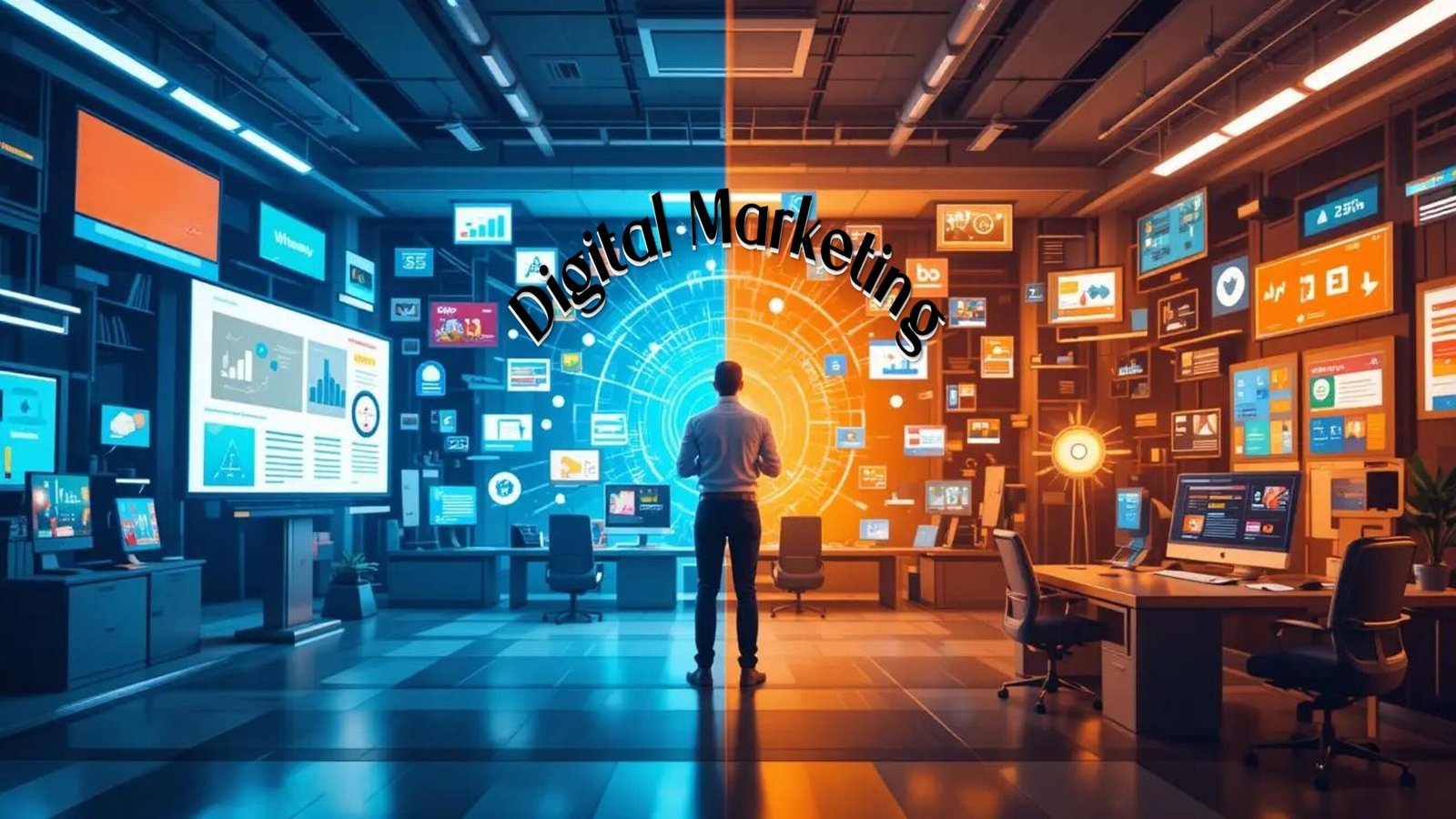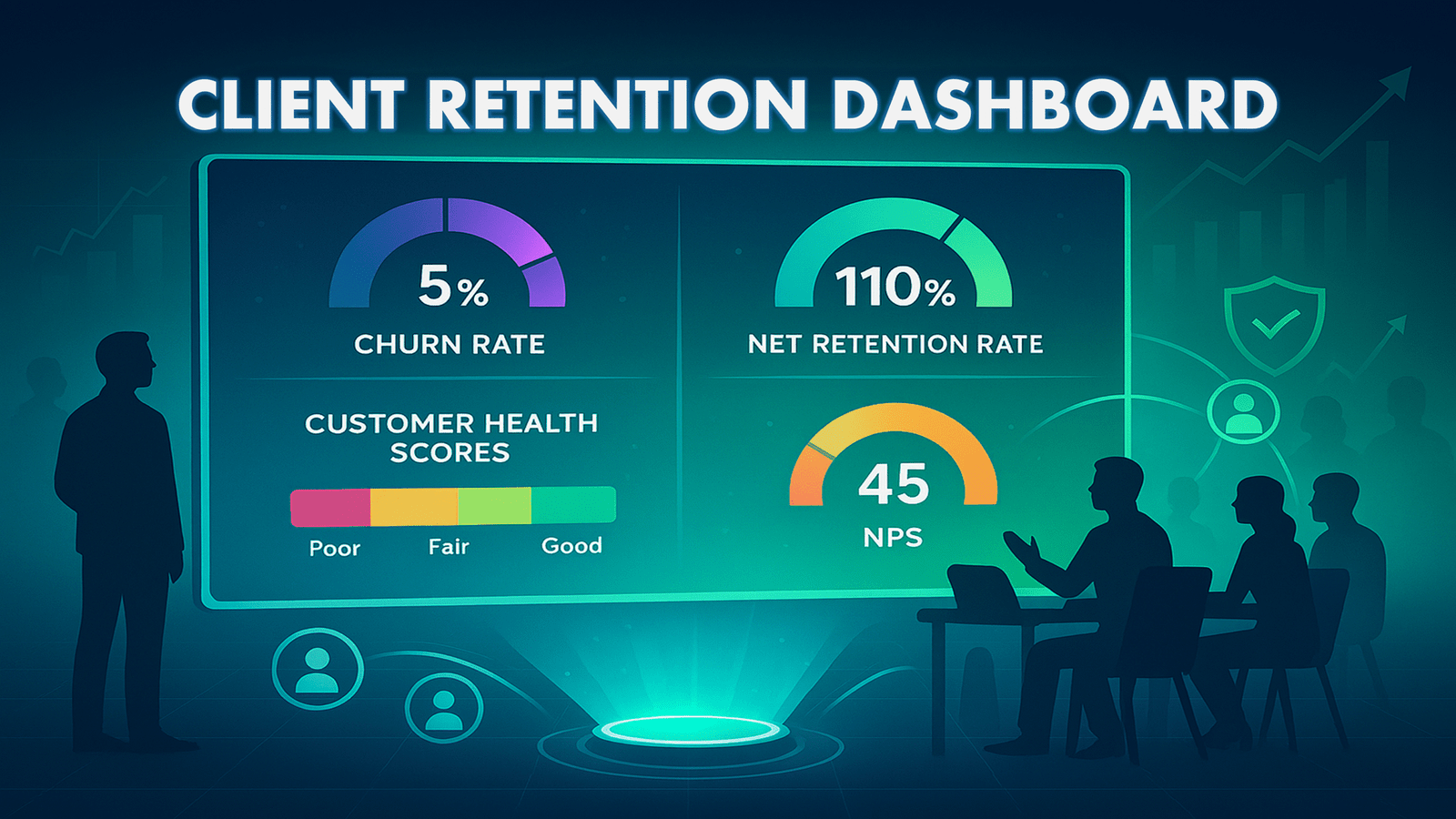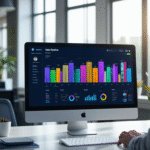Now Reading: Traditional and Digital Marketing for Sustainable Success
-
01
Traditional and Digital Marketing for Sustainable Success

Traditional and Digital Marketing for Sustainable Success
Digital marketing impact is clear. Statistics show it drives 38% of a company’s revenue today. Companies focusing on customer experience through working marketing strategies achieve 17% revenue growth. This stands in stark contrast to others who see only 3% growth.
Traditional marketing channels remain relevant. Consumer behavior has moved dramatically toward online platforms. This shift has revolutionized business-customer connections. Digital platforms now serve as the key touchpoint for customer participation and sales conversion.
Businesses face a significant decision point about their marketing budget allocation. Your 2025 strategy needs a clear understanding of ROI, whether you run a growing business or lead a marketing team. Let’s get into both traditional and digital marketing approaches to help you make smart marketing investment decisions.
Current Marketing Landscape
Marketing has revolutionized itself with nearly 5 billion internet users who participate in digital platforms [1]. Brands now fiercely compete for consumer attention in this new economy.
Rise of Marketing Channels
Marketing channels have grown beyond TV, radio, and print media. Digital technologies have brought new ways to connect through email, social media, websites, and mobile applications. 60% of the global population can now access platforms like Facebook, YouTube, WhatsApp, Instagram, and TikTok [1].
The difference between traditional and digital channels stands out through measurement and targeting capabilities. Brands can now target specific audiences based on location, age, interests, and past browsing behavior [1]. These platforms are available to businesses of all sizes because they need minimal upfront investment.
Consumer Behavior Changes
People have changed how they find and buy products. 41% of social media users now buy through social media platforms without hesitation [2]. This trend reaches beyond young people – Gen X shows a 16% increase while Boomers show a 60% increase in finding products through social media [2].
Major changes in consumer behavior include:
- Small businesses see a 42% increase in support, up 8% from last year [2]
- Consumers prefer brands that take positions on social issues [2]
- Authentic, raw content wins over polished material [3]
- People just need individual-specific experiences and real connections with brands [3]
Businesses must stay flexible with their marketing strategies. The digital world requires quick adaptation to platform updates and new trends [1]. Marketing teams must balance what consumers want now with future strategy planning to stay relevant in this fast-changing environment.
Digital Marketing Performance
Digital marketing channels show their real value through performance metrics. Search engine optimization stands out with an impressive 748% ROI over three years [4]. Email marketing brings in INR 3037.70 for every rupee spent [5].
Channel-specific Returns
Each digital channel delivers different results based on business goals and how they’re used. Search engine marketing (SEM) delivers a return of 36% [4] through targeted ad campaigns. B2B marketing on LinkedIn proves valuable with a 229% ROI [4] from organic engagement.
The most profitable digital marketing channels include:
- PPC advertising: INR 168.76 return for every INR 84.38 spent [6]
- Google Ads: INR 675.04 return for every INR 84.38 invested [6]
- Email campaigns: INR 3712.74 return for every INR 84.38 allocated [6]
Conversion Rate Analysis
Conversion rates tell us how well marketing efforts work. These rates change based on industry standards and campaign goals [7]. Companies need to watch multiple conversion points, from form submissions to purchases, to measure their success accurately.
Smart companies use several proven strategies to boost their conversion rates. They test landing pages, improve user experience (UX), and make their website interface (UI) better [7]. Websites with easy navigation consistently convert more visitors [7].
Cost Per Acquisition
Cost Per Acquisition (CPA) helps measure marketing efficiency. This metric shows how much money it takes to get a new customer through different digital channels [8]. Marketing budgets work better when businesses understand their CPA across platforms.
CPA effectiveness varies by channel:
- PPC campaigns show quick results but need careful budget management
- Social media ads offer targeted reach with flexible costs
- Content marketing costs less but needs more time to show results [5]
Companies that keep their CPAs low while getting quality leads perform better overall. Regular monitoring and adjusting these metrics helps businesses optimize their digital marketing strategies [9].
Traditional Marketing Effectiveness
“A Nielsen study for Google featured in the new research shows that a 1% increase in brand awareness leads to a 0.4% increase in short-term sales and a 0.6% increase in long-term sales.” — Think with Google, Google’s marketing research and insights platform
Traditional marketing shows remarkable staying power, with print advertising revenue projected to reach ₹296 billion in 2024 [10]. These numbers prove that conventional marketing methods still work well.
Brand Building Impact
Traditional marketing channels are great at creating lasting brand impressions through their wide reach and physical presence. Print media, television, and radio advertisements create deeper connections with audiences because they reach so many people [11]. Traditional channels encourage trust and credibility – which is vital for businesses that want to build strong market positions [12].
Traditional marketing’s effect on brand building shows up in several key metrics:
- Print and radio advertising showing 15% year-over-year increase in rural markets [10]
- Outdoor advertising spending growing by 8% annually [10]
- Radio advertising contributing ₹30 billion in revenue [10]
All the same, traditional marketing’s success goes beyond just numbers. These channels give people real experiences that digital platforms can’t match, which leads to better memory recall and longer engagement times [11].
Long-term Value Assessment
Like building a strong foundation, traditional marketing creates lasting value through consistent brand presence. Customer lifetime value is key here, since keeping existing customers costs less than finding new ones [13]. Traditional marketing methods help keep customers loyal to brands by building trust and credibility.
Traditional marketing’s long-term value really shows in rural markets, where these channels keep people engaged. Rural advertising spending has grown faster than urban markets [10], which proves that conventional marketing approaches still work well with specific groups.
Traditional marketing methods work best for:
- Building trust through time-tested media channels [14]
- Creating brand recognition through repeated exposure [12]
- Reaching people who aren’t available through digital platforms [10]
Traditional marketing builds brands well because it gives people real experiences and builds credibility over time. This approach keeps evolving – outdoor advertising and print media adapt to market changes while keeping their core strengths in building lasting relationships with brands.
ROI Measurement Framework
Marketing success measurement needs a structured framework that combines smart data collection with powerful analysis tools. A good ROI measurement framework tracks both financial and non-financial metrics. This gives you a detailed view of your marketing performance.
Data Collection Methods
Good data collection is the backbone of ROI measurement. Companies employ tracking pixels to monitor customer experiences across digital platforms [15]. CRM integrations record every sales interaction and provide valuable insights into the customer lifecycle. Successful companies don’t rely on just one data source. They use multiple collection methods to ensure their data stays accurate and complete [2].
Data quality determines how reliable your ROI calculations will be. Companies should check and verify their data points regularly [2]. This process needs:
- Database cleansing and duplicate removal
- Email address validation
- Standardized data entry protocols
- Cross-reference verification
Success Metrics
Many metrics exist, but picking the right KPIs that match business goals is vital. The simple ROI formula, (Sales Growth – Marketing Cost) / Marketing Cost, is the foundation of measurement [15]. Smart organizations track multiple metrics:
Marketing teams aim for a 5:1 ratio as their ROI benchmark, with 10:1 showing excellent performance [15]. Companies need to factor in external influences like seasonal trends and market events while evaluating their marketing success [15].
Analysis Tools
Your business requirements and integration needs determine which analysis tools work best. Marketing automation tools make campaign tracking easier and deliver up-to-the-minute insights into performance metrics [3]. These tools should naturally merge online and offline touchpoints, especially when you have multiple channels for customer conversion [16].
Popular analysis platforms offer different features:
- Google Analytics: Tracks website performance and conversion paths [17]
- CRM Systems: Monitor lead progression and sales cycles [15]
- Attribution Tools: Connect marketing activities to revenue outcomes [17]
Tool effectiveness depends on proper setup and regular maintenance. Your analytics setup should have proper tracking parameters and event monitoring [18]. Regular audits of analytics accounts help maintain data accuracy and reliability.
Cost-Benefit Analysis
Marketing campaign analysis reveals striking differences in investment patterns and returns. A complete cost-benefit analysis helps businesses make informed decisions about their marketing investments.
Original Investment Requirements
Digital marketing campaigns just need different levels of upfront investment based on chosen channels. Email marketing campaigns start with minimal investment. We needed simple infrastructure and content creation tools [19]. PPC campaigns just need an original budget of approximately INR 2953.32 per customer acquisition [19].
Social media advertising offers flexible entry points, with costs averaging INR 19.41 per click in the United States [20]. Traditional channels require substantial upfront investments. Companies must commit significant capital before launching campaigns [1].
Ongoing Maintenance Costs
Maintenance expenses are a vital component of marketing budgets that include various elements to ensure campaign effectiveness. These costs include:
- Platform subscription fees
- Content creation and updates
- Technical support and monitoring
- Analytics tools and reporting systems
- Training and skill development [21]
Industry data shows digital maintenance costs typically range between INR 4219.02 to INR 84380.45 monthly, based on campaign scope and complexity [22]. Companies must also factor in labor costs, including benefits, training, and potential overtime expenses [23].
Expected Returns Timeline
Marketing returns vary substantially across channels and strategies. Digital campaigns show results within three to four months. Full optimization comes around the 12-month mark [24]. Email marketing demonstrates exceptional efficiency and generates INR 3037.70 for every rupee invested [19].
Companies should follow this well-laid-out timeline to track performance:
- Month 1-3: Campaign setup and baseline establishment
- Month 4-6: Original ROI assessment and optimization
- Month 6-12: Performance scaling and refinement
- Month 12-18: Maximum campaign optimization [24]
Successful campaigns reach a 5:1 ratio as a standard for good ROI. Exceptional performers achieve 10:1 [25]. This performance metric serves as a reliable indicator to evaluate marketing investments in both traditional and digital channels.
Future ROI Trends
Technological advances and changing consumer priorities continue to shape marketing ROI measurement. The global ad spending will surge beyond INR 84.38 trillion by 2025 [26]. This represents unprecedented growth in marketing investments.
Technology Effect
AI leads ROI optimization and delivers 5-8 times higher returns through advanced personalization [27]. Companies that use evidence-based strategies see a 10-25 percentage points increase in marketing effectiveness [28].
Marketing mix modeling (MMM) is a vital tool to measure upper and lower-funnel activities. The optimal media investment split suggests:
- 50-60% of budget to brand building activities
- 40-50% for performance-related tactics
- 1% increase in brand awareness results in 0.4% increase in short-term sales [29]
AI-powered predictive analytics help businesses understand consumer behavior patterns better. Companies can now predict campaign performance more accurately and reduce customer acquisition costs [27].
Market Development Predictions
Marketers face new challenges in data collection due to privacy regulations and browser policies [28]. Only 40% of marketers have formal measurement solutions [28]. This shows significant potential for analytics adoption growth.
Social media advertising will reach INR 6919.20 billion by 2025 [26]. Consumer priorities guide this growth. Platforms like TikTok Shop gain prominence as focus moves toward niche creators and social commerce.
Mobile marketing shows promising growth. In-app advertising will make up 82.3% of the INR 19238.74 billion mobile ad spending [26]. Branded apps now include AI-powered features that improve user experience and ROI tracking.
Future marketing strategies need agile processes and immediate data access [28]. Companies that prioritize evidence-based decision-making gain competitive advantage. Advanced analytics tools make marketing effectiveness more measurable than ever before.
Comparison Table
| Aspect | Digital Marketing | Traditional Marketing |
|---|---|---|
| Revenue Impact | 38% of company revenue | Not mentioned |
| ROI Examples | – SEO: 748% over 3 years – Email: ₹3037.70 per rupee invested – LinkedIn: 229% – Google Ads: ₹675.04 per ₹84.38 invested | Print advertising revenue: ₹296 billion (2024) |
| Original Costs | – PPC: ₹2953.32 per customer acquisition – Social media: ₹19.41 per click | Requires substantial upfront investment |
| Maintenance Costs | ₹4219.02 to ₹84380.45 monthly | Not mentioned |
| Market Reach | Nearly 5 billion internet users; 60% of global population on social media | Strong in rural markets; 15% YoY increase in rural areas |
| Key Strengths | – Precise targeting – Instant tracking – Lower upfront costs – Live optimization | – Building lasting brand impressions – Higher recall rates – Deeper involvement – Strong credibility |
| Results Timeline | 3-4 months for original results; 12 months for full optimization | Long-term value focus; Builds trust over time |
| Growth Trends | Social media ad spending to reach ₹6919.20 billion by 2025 | 8% annual growth in outdoor advertising; Radio advertising: ₹30 billion revenue |
Conclusion
Success in marketing by 2025 just needs a mix of digital and traditional methods. Digital channels show remarkable ROI numbers, with SEO delivering 748% returns and email marketing bringing in ₹3037.70 for every rupee spent. Traditional marketing still builds strong brands and reaches deep into markets, especially when you have rural areas to cover.
The numbers show that digital platforms are great at targeting specific audiences and measuring results right away. Traditional channels create lasting brand impressions and people remember them better. Companies should review their specific needs, audience, and long-term goals before picking their marketing channels.
The key isn’t picking one method over another – it’s knowing how each channel helps achieve different business goals. Companies that blend evidence-based digital strategies with tested traditional methods get the best market results. This balanced strategy captures quick returns and builds lasting brand value.
Marketing keeps changing as technology advances. AI-powered analytics and personalization now bring 5-8 times higher returns, while new privacy rules are changing how we collect data. Smart businesses stay flexible and adjust their marketing mix as new opportunities come up.
FAQs
Q1. What is the projected growth for digital marketing in 2025? Digital marketing is expected to see significant growth by 2025. Paid social media advertising, for instance, is forecasted to grow by 8.7% in 2025, reaching around INR 19,000 billion. This represents a steady year-over-year growth of about 3.86%.
Q2. How does the ROI of digital marketing compare to traditional marketing? Digital marketing often provides a higher ROI compared to traditional marketing due to its lower costs and wider reach. For example, SEO can deliver up to 748% returns over three years, while email marketing generates INR 3037.70 for every rupee invested. However, traditional marketing still holds value in brand building and reaching certain demographics.
Q3. What is considered a good ROI percentage for digital marketing campaigns? A commonly accepted benchmark for a good marketing ROI is 5:1, which translates to a 500% return. This means for every rupee spent on marketing, the company receives five rupees in return. Exceptional performance is considered to be a 10:1 ratio or higher.
Q4. How will AI impact digital marketing effectiveness by 2025? AI is expected to significantly enhance digital marketing effectiveness by 2025. It’s projected to deliver 5-8 times higher returns on marketing investments through advanced personalization techniques. AI will also be crucial in automating tasks, creating content, and analyzing data to predict trends more accurately.
Q5. What role will traditional marketing play in 2025 despite digital growth? Despite the rapid growth of digital marketing, traditional marketing will continue to play a vital role in 2025, especially in brand building and reaching specific demographics. Print advertising revenue is projected to reach INR 296 billion in 2024, and traditional channels like outdoor advertising and radio are still showing growth, particularly in rural markets.
References
[1] – https://www.marketingeye.com.au/marketing-blog/balancing-your-marketing-budget-traditional-vs-digital-marketing.html
[2] – https://www.leadforensics.com/blog/marketing-software-roi/
[3] – https://www.youngurbanproject.com/digital-marketing-roi/
[4] – https://firstpagesage.com/reports/digital-marketing-roi-statistics/
[5] – https://www.springboard.com/blog/business-and-marketing/digital-marketing-channels/
[6] – https://www.webfx.com/blog/marketing/which-marketing-channels-produce-the-highest-roi/
[7] – https://www.coursera.org/articles/what-is-conversion-rate
[8] – https://www.salesforce.com/in/blog/what-is-cpa/
[9] – https://blog.hubspot.com/marketing/cost-per-acquisition
[10] – https://www.digitosis.com/post/digital-vs-traditional-marketing-trends-2025
[11] – https://highland-marketing.com/resources/marketing-roi-digital-vs-traditional/
[12] – https://www.htmedia.in/blog/traditional-marketing-vs-digital-marketing-key-differences
[13] – https://www.oracle.com/in/cx/marketing/marketing-roi/
[14] – https://www.kraftshala.com/blog/digital-marketing-vs-traditional-marketing/
[15] – https://www.marketingevolution.com/marketing-essentials/marketing-roi
[16] – https://www.5x.co/blogs/data-roi-tools
[17] – https://www.ruleranalytics.com/blog/analytics/marketing-roi-tool/
[18] – https://measureschool.com/marketing-measurement/
[19] – https://www.klipfolio.com/resources/kpi-examples/digital-marketing/return-on-marketing-investment
[20] – https://bigsea.co/ideas/short-vs-long-term-digital-marketing-strategies/
[21] – https://kvytechnology.com/blog/software/ongoing-maintenance-and-subscription-fees/
[22] – https://www.investopedia.com/terms/m/maintenance-expenses.asp
[23] – https://upkeep.com/learning/justifying-maintenance-costs/
[24] – https://www.321webmarketing.com/blog/when-should-you-start-to-see-results-from-your-digital-marketing-campaign/
[25] – https://dashthis.com/kpi-examples/return-on-marketing-investment/
[26] – https://www.marketingdive.com/news/marketing-predictions-for-2025/736381/
[27] – https://www.micron.com/about/blog/applications/ai/how-ai-drives-marketing-roi
[28] – https://www.bcg.com/publications/2022/human-tech-equation-for-improving-marketing-roi
[29] – https://www.thinkwithgoogle.com/intl/en-emea/marketing-strategies/data-and-measurement/unlock-hidden-marketing-roi/
















Pingback: AI-Powered Marketing Content: Save Time & Drive Results in 2025 - Pursuit Pages